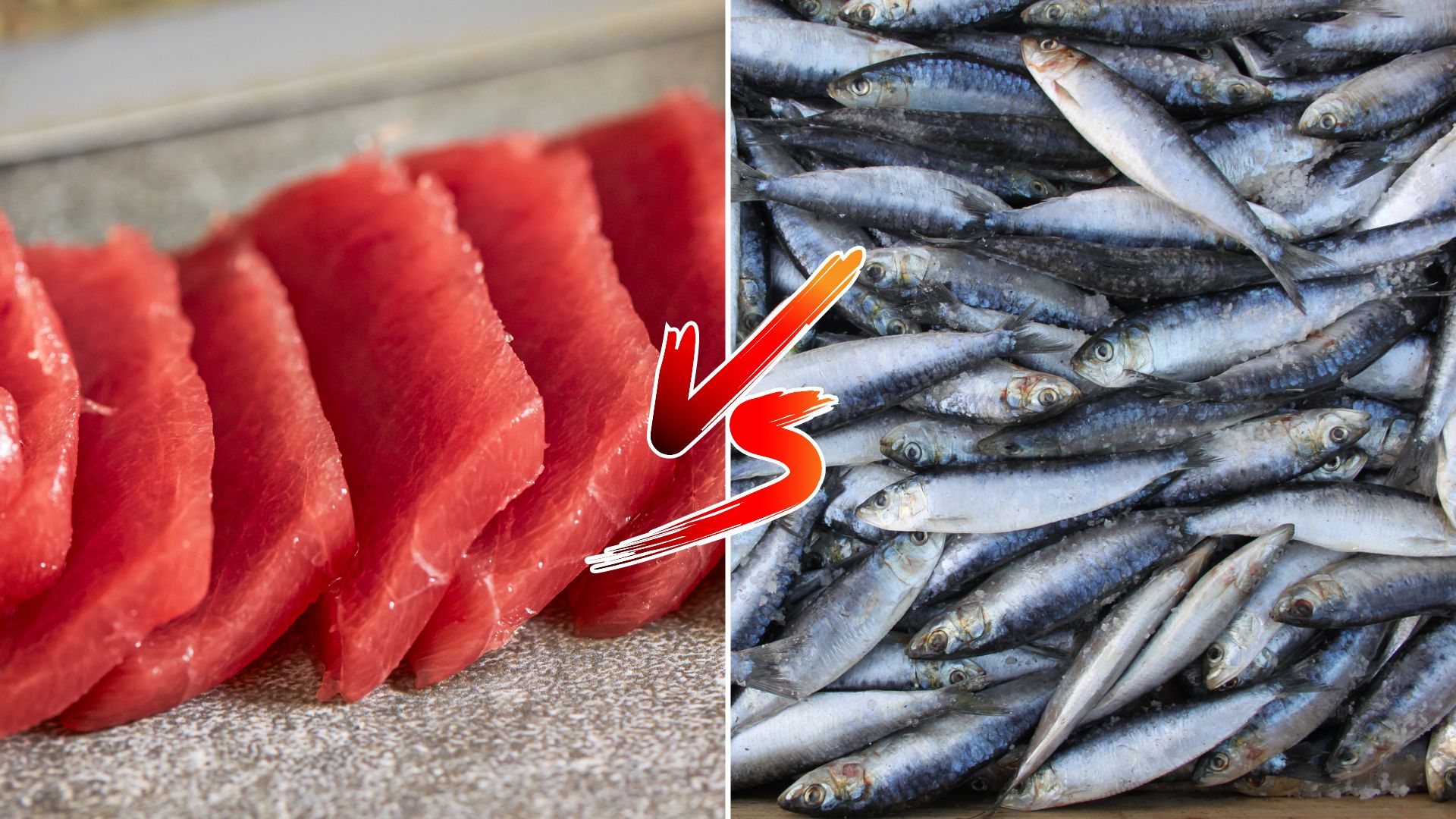Tuna and sardines are the most commonly consumed types of fish worldwide. They are both rich in protein, omega-3 fatty acids, vitamins, and minerals, which makes them beneficial for our health. However, people often confuse themselves when choosing between these tuna and sardines. In this article, we will compare the nutritional value, health benefits, environmental impact, taste, culinary uses, and price of tuna and sardines to help you make an informed decision.
Tuna vs Sardines: Nutritional Comparison

Tuna and sardines are both types of fish known for their nutritional value. Here’s a breakdown of their nutritional comparison:
Protein: Both tuna and sardines are good sources of protein, which is important for building and repairing tissues in the body. Tuna contains around 25 grams of protein per 100 grams, while sardines contain around 24 grams of protein per 100 grams.
Omega-3 Fatty Acids: Both tuna and sardines are rich in omega-3 fatty acids, which have been linked to a variety of health benefits, such as reducing inflammation, improving heart health, and supporting brain function. However, sardines are considered to be one of the best sources of omega-3s, containing around 1.5 grams of omega-3s per 100 grams, while tuna contains around 0.2 grams of omega-3s per 100 grams.
Calories: Tuna is a relatively low-calorie food, with around 100 calories per 100 grams. Sardines are slightly higher in calories, with about 208 calories per 100 grams.
Fat: Tuna and sardines contain healthy fats, but sardines are higher in fat than tuna. Sardines contain around 11 grams of fat per 100 grams, while tuna contains about 1.2 grams of fat per 100 grams.
In conclusion, while both tuna and sardines are healthy choices, sardines are richer in omega-3s, calcium, and calories, while tuna is lower in calories and fat.
Tuna vs Sardines: Macronutrient Comparison

In terms of macronutrients, both tuna and sardines are low in carbohydrates and high in protein and healthy fats. However, tuna is a leaner fish with lower fat content, while sardines are oily fish with higher fat content. A 100-gram serving of canned tuna contains 25 grams of protein and only 1 gram of fat, while a 100-gram serving of canned sardines contains 22 grams of protein and 12 grams of fat.
Tuna vs Sardines: Micronutrient Comparison

In terms of micronutrients, both tuna, and sardines are rich in vitamins and minerals essential for our health. However, compared to tuna, sardines are a better source of certain nutrients, such as vitamin B12, vitamin D, and calcium. A 100-gram serving of canned sardines contains 7.6 mcg of vitamin B12, 250 IU of vitamin D, and 382 mg of calcium. In comparison, a 100-gram serving of canned tuna contains 2.5 mcg of vitamin B12, 60 IU of vitamin D, and 10 mg of calcium.
Tuna vs Sardines: Health Benefits

Both tuna and sardines offer numerous health benefits due to their high nutritional value. Here are some of the most essential health benefits of these two fish:
Heart Health:
Tuna and sardines are rich in omega-3 fatty acids, which are essential for heart health. Omega-3 fatty acids can lower blood pressure, reduce inflammation, and decrease the risk of heart disease. A 2012 review of 20 studies found that people who ate more fish had a lower risk of heart disease, stroke, and heart failure.
Brain Health:
Omega-3 fatty acids are also crucial for brain health and can improve cognitive function, memory, and mood. A 2016 study found that regular fish consumption was associated with better cognitive performance in older adults.
Eye Health:
Tuna and sardines are rich in vitamin A and omega-3 fatty acids, which are essential for eye health. A 2014 study found that eating fish can reduce the risk of age-related macular degeneration, a common cause of blindness in older adults.
Other Health Benefits:
Both tuna and sardines offer other health benefits, such as reducing inflammation, improving immune function, and decreasing the risk of certain cancers.
Tuna vs Sardines: Environmental Impact

The environmental impact of tuna and sardines is essential for many people. Overfishing, bycatch, and depletion of fish stocks are significant concerns associated with commercial fishing.
Overfishing and Depletion of Fish Stocks:
Tuna is a popular and highly valued fish in high demand worldwide, leading to overfishing and depletion of tuna stocks in many parts of the world. Some tuna species, such as bluefin tuna, are considered endangered due to overfishing. On the other hand, Sardines are more abundant and can be found in many parts of the world. They reproduce quickly and have a short lifespan, which makes them a more sustainable choice.
Bycatch and Impact on Other Marine Species:
Commercial fishing of tuna and sardines can also impact other marine species. Bycatch, the unintentional capture of non-target species, is a significant problem in commercial fishery. Bycatch can include endangered species, such as dolphins, sea turtles, and sharks. Tuna fishing has a higher rate of bycatch compared to sardine fishing.
Sustainability of Tuna and Sardine Populations:
When choosing between tuna and sardines, it is essential to consider the sustainability of the fish populations. Tuna stocks have been declining in many parts of the world, and some species are considered overfished or even endangered. On the other hand, Sardines are generally considered a more sustainable choice due to their abundance and fast reproductive cycle.
Taste and Culinary Uses of Tuna and Sardines

Tuna and sardines offer different flavor profiles and can be used in various dishes. Tuna has a mild flavor and firm texture, making it a versatile fish that can be used in multiple words. Tuna is often served raw in sushi and sashimi dishes, where its mild flavor can be paired with various sauces and toppings. It is also commonly used in grilled or seared dishes, such as tuna steaks or salads. Tuna can also be canned and used in various recipes, such as tuna salad or casserole.
Sardines, on the other hand, have a richer, more assertive flavor, making them a popular choice for those who enjoy the taste of oily fish. Sardines are often used in canned form for sandwiches, salads, and pasta dishes.
They are also commonly served grilled or smoked as a standalone dish or as an ingredient in other recipes. Sardines can be used to add flavor to a variety of dishes, including stews, soups, and sauces. Because of their strong flavor, sardines are often paired with solid seasonings such as garlic, lemon, rosemary, and thyme.
Flavor Profile of Tuna and Sardines:
The flavor profile of tuna and sardines can be quite different due to the variations in the taste and texture of these fish. Tuna has a mild flavor, a firm, meaty texture, and a slightly sweet taste. It is often described as having a “clean” taste and a subtle umami flavor that pairs well with various seasonings and sauces. Tuna has a light, delicate flavor often complemented by citrus, soy sauce, ginger, and other mild flavors.
On the other hand, Sardines have a more robust, assertive flavor that is often described as “rich” or “oily.” They have a tender, flaky texture and a distinctive, slightly salty taste that can be pretty pronounced. Sardines are known for their strong umami flavor, which makes them an excellent ingredient for savory dishes. They are often paired with bold flavors like garlic, lemon, and herbs and are a popular choice for Mediterranean and Italian dishes. Sardines are also commonly used in canned form, where they are often packed in oil or tomato sauce to help enhance their flavor.
Cooking Methods and Recipes for Tuna and Sardines:
Tuna can be cooked in various ways, such as grilling, searing, or baking. It can also be used in salads, sandwiches, and casseroles. Sardines are often grilled, roasted, or fried and can be used in pasta dishes, sandwiches, and salads.
Price Comparison of Tuna and Sardines

The price of tuna and sardines can vary depending on factors such as the type of fish, the fishing method, and the location. However, in general, canned sardines are often cheaper than canned tuna.
Factors that Affect the Price of Tuna and Sardines:
The price of tuna and sardines can be affected by factors such as the fishing method, the location, and the processing method. Tuna caught using sustainable fishing methods or processed in a way that preserves its quality can be more expensive than lower-quality tuna. Sardines with added ingredients such as olive oil or tomato sauce can be more costly than plain canned ones.
Cost Comparison of Canned Tuna and Sardines:
In general, canned sardines are often cheaper than canned tuna. For example, a 4-ounce can of sardines can cost around $1.50, while a 5-ounce tuna can cost about $2.50.
Conclusion

In conclusion, tuna and sardines are healthy and nutritious food choices. Tuna is a leaner fish with lower fat content, while sardines are oily fish with higher fat content. Sardines are a better source of certain micronutrients, such as vitamin B12, vitamin D, and calcium. Tuna and sardines offer numerous health benefits, such as improving heart, brain, and eye health. Regarding environmental impact, sardines are generally considered a more sustainable choice. Tuna fishing has led to overfishing and depletion of fish stocks, while s
sardines are more abundant and reproduce quickly. It is important to choose sustainable seafood sources to ensure our oceans’ health and the future availability of these fish.
Regarding taste and culinary uses, tuna and sardines offer different flavor profiles and can be used in various dishes. Tuna is often served raw in sushi and sashimi dishes, while sardines are more commonly used in canned for sandwiches, salads, and pasta dishes. Both tuna and sardines can be cooked in a variety of ways and can be used in a range of recipes. Microsoft Excel Crack is the world’s most popular and well-known program. Although Microsoft Excel was first released in 1987, it has undergone
While the price of tuna and sardines can vary depending on factors such as the type of fish, the fishing method, and the location, in general, canned sardines are often cheaper than canned tuna. It is essential to consider the quality and sustainability of the fish when making purchasing decisions, as well as the price.
Ultimately, whether you choose tuna or sardines depends on your personal preferences, nutritional needs, and values. Both fish offer a range of health benefits and can be incorporated into a healthy and balanced diet. Choosing sustainable sources of seafood can also help to protect our oceans and ensure the availability of fish for future generations.
In conclusion, while there are some differences between tuna and sardines in terms of nutrition, environmental impact, taste, and price, both are nutritious and healthy choices for our diets. It is important to choose sustainable seafood sources to ensure our oceans’ health and the future availability of these fish. Whether you prefer the mild flavor of tuna or the rich flavor of sardines, both can be incorporated into a range of dishes and offer numerous health benefits.
